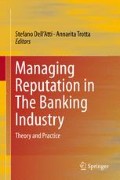Abstract
The purpose of this chapter is to describe the reputational impact of the Libor case on Barclays by outlining the ensuing process of rebuilding trust and implementing cultural changes. This chapter is organized as follows. First, we briefly describe the major elements of the Libor scandal, including the investigations, fines and regulatory actions. Then, we propose a focus on Barclays, the company that arguably experienced the most significant impact of the media scandal in 2012. In our case study, we describe the course of events that led Barclays into a reputational crisis, identify and describe the core elements of the restructuring concept. In closing, we consider the lessons learned from this series of events.
Access this chapter
Tax calculation will be finalised at checkout
Purchases are for personal use only
Notes
- 1.
In April 2013, the FSA was replaced by two new regulatory bodies, the Prudential Regulation Authority (PRA) and the Financial Conduct Authority (FCA).
- 2.
The term ‘Barclays’ refers both to “Barclays Plc Group” and to “Barclays Bank Plc”. For this chapter, we used documents published on the Barclays web site (http://www.barclays.com/) related to both Barclays Plc Group and to Barclays Bank Plc to obtain a complete picture of the company’s historical evolution.
- 3.
Automated keyword-based searches of online news archives in the media database Factiva reveal more than 4705 articles related to the words “Libor” and “manipulation”. The search was conducted in May 2015. The selected time period was “01/01/2008–08/05/2015”. Factiva provides a premier collection of the world’s top media outlets, web media, and trade and consumer publications, giving immediate access to thousands of sources in 28 languages from nearly 200 countries. The database contains 35 years of articles, analyst reports and tweets. The top news sources in Factiva include the Wall Street Journal, Dow Jones Newswires, the New York Times, the Sydney Morning Herald, South China Morning Post and Le Monde. See http://new.dowjones.com/factiva-sources/
References
Abrantes-Metz RM (2012) Why and how should the libor be reformed? Available at SSRN: http://ssrn.com/abstract=2094542. Accessed 04 Sept 2015
Abrantes-Metz RM, Kraten M, Metz AD et al (2012) Libor manipulation? J Bank Financ 36(1):136–150
Agarwal A, Jain M (2015) Recent development in Libor. Abhinav-National Monthly Refereed J Res Comm Manag 4(3):107–114
Ashton P, Christophers B (2015) On arbitration, arbitrage and arbitrariness in financial markets and their governance: unpacking LIBOR and the LIBOR scandal. Econ Soc 44(2):188–217
Bank for International Settlements (2013) Towards better reference rate practices: a central bank perspective. Basel
Barclays Plc (2011) Annual Report. London
Barclays Plc (2012) Annual Report. London
Barclays Plc (2013a) Annual Report. London
Barclays Plc (2013b) Barclays’ response to the Salz Review. London
Barclays Plc (2013c) Strategic Report. London
Barclays Plc (2014a) Annual Report. London
Barclays Plc (2014b) Statement on anti-money laundering. London
Barclays Plc (2014c) Strategic Report. London
Barclays Bank Plc (2011) Annual Report. London
Barclays Bank Plc (2012) Annual Report. London
Barclays Bank Plc (2013a) Annual Report. London
Barclays Bank Plc (2013b) Strategic Review. London
Barclays Bank Plc (2014) Annual Report. London
Bonfim D, Kim M (2014) Liquidity risk in banking: is there herding? Available at SSRN: http://ssrn.com/abstract=2163547. Accessed 04 Sept 2015
Commodity Futures Trading Commission (2012) Order instituting proceedings pursuant to Sections 6(C) and 6(D) of The Commodity Exchange Act, as amended, making findings and imposing remedial sanctions. Washington, DC
Coombs WT, Holladay SJ (eds) (2011) The handbook of crisis communication. Wiley-Blackwell, Oxford
Cui J, In FH, Maharaj EA (2012) What drives the Libor-OIS spread? Evidence from five major currency Libor-OIS spreads. Available at SSRN: http://ssrn.com/abstract=2173944. Accessed 04 Sept 2015
Dallas L (2012) Short-termism, the financial crisis, and corporate governance. Available at SSRN: http://ssrn.com/abstract=2006556. Accessed 04 Sept 2015
Financial Conduct Authority (2013) Final Notice 2013: ICAP Europe Ltd. Ref Number 188984. London
Financial Services Authority (2012) Report: Final Notice – FSA. Ref Number 122702. London
Fouquau J, Spieser PK (2015) Statistical evidence about LIBOR manipula tion: a “Sherlock Holmes” investigation. J Bank Financ 50:632–643
Hou D, Skeie DR (2014) LIBOR: origins, economics, crisis, scandal, and reform. Available at SSRN: http://ssrn.com/abstract=2423387. Accessed 04 Sept 2015
House of Commons Treasury Committee (2012) Fixing LIBOR: some preliminary findings. HC 481–I. London
International Monetary Fund (2008) Global Financial Stability Report. International Monetary Fund, Washington, DC
Keay A (2011) Risk, shareholder pressure and short-termism in financial in stitutions: does enlightened shareholder value offer a panacea? LFMR 5(6):435–448
King TB, Lewis KF (2014) What drives bank funding spreads? Available at SSRN: http://ssrn.com/abstract=2539711. Accessed 04 Sept 2015
McConnell PJ (2013) Systemic operational risk: the LIBOR manipulation scandal. J Oper Risk 8(3):59–99
Monticini A, Thornton DL (2013) The effect of underreporting on LIBOR rates. J Macroecon 37:345–348
O’Brien J, Gilligan G (eds) (2013) Integrity, risk and accountability in capital markets: regulating culture. Bloomsbury Publishing, London
Rappaport A (2005) The economics of short-term performance obsession. Financ Anal J 61(3):65–79
Rappaport A, Bogle JC (2011) Saving capitalism from short-termism: how to build long-term value and take back our financial future. McGraw Hill Professional, New York, NY
Reputation Institute (2013) UK RepTrakTM Pulse 2013. Forbes
Salz A (2013) The Salz review: an independent review of Barclays’ business practices. London
Author information
Authors and Affiliations
Corresponding author
Editor information
Editors and Affiliations
Rights and permissions
Copyright information
© 2016 Springer International Publishing Switzerland
About this chapter
Cite this chapter
Carè, R. (2016). The Libor Case: A Focus on Barclays. In: Dell’Atti, S., Trotta, A. (eds) Managing Reputation in The Banking Industry. Springer, Cham. https://doi.org/10.1007/978-3-319-28256-5_3
Download citation
DOI: https://doi.org/10.1007/978-3-319-28256-5_3
Published:
Publisher Name: Springer, Cham
Print ISBN: 978-3-319-28254-1
Online ISBN: 978-3-319-28256-5
eBook Packages: Economics and FinanceEconomics and Finance (R0)

